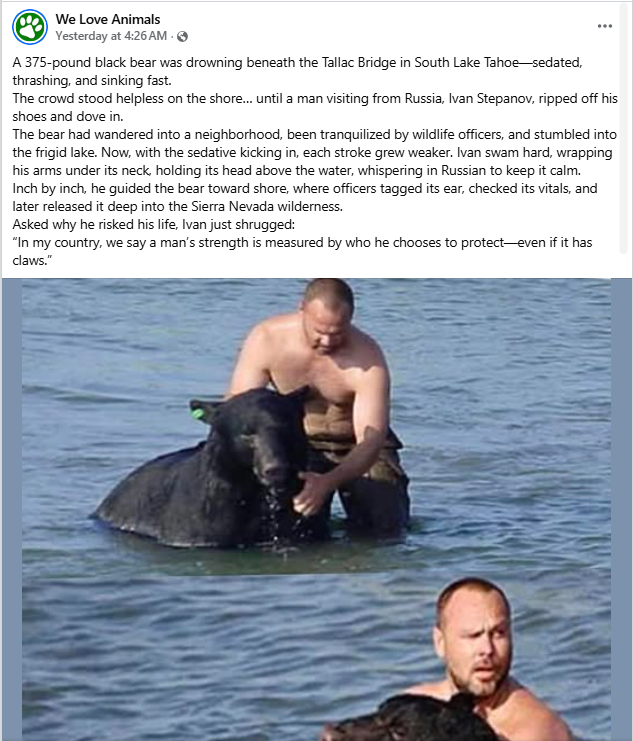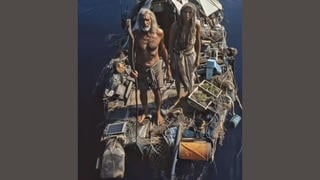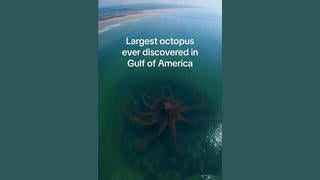
Did a Russian visitor named Ivan Stepanov rescue a tranquilized bear that was drowning in Lake Tahoe? No, that's not true: The dramatic story shared on social media is ripped off from the real-life heroics of Florida wildlife biologist Adam Warwick, who pulled a tranquilized bear from the water in a Florida harbor in 2008. The photos used in a false Facebook post showed a bare-chested Warwick -- not Stepanov -- helping a disoriented black bear to shore.
The claim appeared in a post (archived here) shared on Facebook on August 13, 2025. It opened:
A 375-pound black bear was drowning beneath the Tallac Bridge in South Lake Tahoe--sedated, thrashing, and sinking fast.The crowd stood helpless on the shore... until a man visiting from Russia, Ivan Stepanov, ripped off his shoes and dove in.The bear had wandered into a neighborhood, been tranquilized by wildlife officers, and stumbled into the frigid lake.
This is what the post looked like on Facebook at the time of writing:
(Source: Facebook screenshot taken on Thu Aug 14 16:11:30 2025 UTC)
The post continued:
Now, with the sedative kicking in, each stroke grew weaker. Ivan swam hard, wrapping his arms under its neck, holding its head above the water, whispering in Russian to keep it calm.
Inch by inch, he guided the bear toward shore, where officers tagged its ear, checked its vitals, and later released it deep into the Sierra Nevada wilderness.
Asked why he risked his life, Ivan just shrugged:
'In my country, we say a man's strength is measured by who he chooses to protect--even if it has claws.'
The real story behind the bear rescue is perhaps best told in a Financial Times article (archived here) published in June 2014, six years after the incident. It is Warwick's personal account "as told to" a reporter. It opened:
It was 2008 and I was working as a wildlife biologist on Alligator Point, a peninsula off the Florida Panhandle. On one side is the Gulf of Mexico and on the other is a bay. There are about 5,000 Florida black bears in the state, so there were a lot of encounters with bears in the beachfront community there.
That summer, someone out fishing spotted a bear swimming in the ocean about a mile off shore and contacted us. Over the next two weeks I kept getting reports of him, and hoped that he would move on.
One evening, our dispatcher called and said, "That bear is under somebody's house." My team and I arrived to find a 375lb seven- or eight-year-old bear. I could tell from his ear tag that he'd been caught in a trap before, so we weren't going to have much success trapping him again. I decided to tranquillise him.
A March 2014 Game & Fish magazine (archived here), which included the same photos used in the Facebook post, also told Warwick's story. It opened:
What do you do when you see a 375-pound black bear take a leap into the Gulf of Mexico? If you are Florida Fish and Wildlife Conservation Commission (FWC) biologist Adam Warwick, you heroically dive into the ocean without hesitation to rescue the six-and-a-half-foot tall animal, thinking more of saving a bruin in peril than about potential injury from razor-sharp claws or fierce teeth.
The bear reportedly wandered into a residential area of James Island, Florida, from the swampy Apalachicola estuary. After Warwick tranquilized the bear, it began swimming away from shore and fell underwater. Warwick removed his shirt and jumped into the water to save the bear from drowning.
The "We Love Animals" Facebook page that shared this post is managed from Sweden, Thailand, and the United Kingdom, according to Meta transparency data.


















